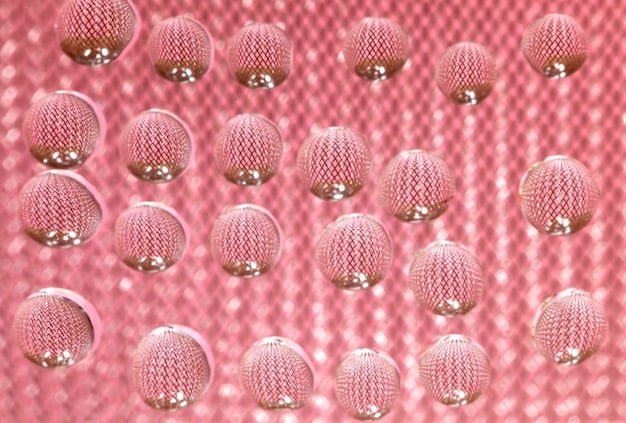The Skincare Ingredient You’re Missing: Why Ceramides Are Essential in 2025

Ceramides are essential skincare ingredients for 2025 because they help maintain the skin’s barrier, retain moisture, and protect against environmental damage, leading to healthier, more resilient skin.
Are you ready to unlock the secret to radiant and resilient skin? The skincare world is constantly evolving, but some ingredients stand the test of time. One such ingredient that’s poised to take center stage in 2025 is ceramides. Understanding **The Skincare Ingredient You’re Missing: Why Ceramides Are Essential in 2025** can transform your skincare routine and deliver visible results.
What Are Ceramides and Why Do They Matter?
Ceramides are lipids (or fats) that are naturally found in high concentrations within the skin’s upper layers. They make up over 50% of the skin’s composition, playing a crucial role in maintaining skin health. Think of them as the glue that holds skin cells together, forming a protective barrier.
This barrier prevents moisture loss and shields the skin from environmental aggressors like pollution, UV rays, and irritants. Without sufficient ceramides, the skin barrier weakens, leading to dryness, irritation, and even premature aging. So, why are they more important than ever in 2025?
The Role of Ceramides in Skin Health
Ceramides are not just any component of the skin; they are integral to its structure and function. Here’s why they are so vital:
- Maintaining Skin Barrier: Ceramides form a waterproof barrier that prevents transepidermal water loss (TEWL), keeping the skin hydrated and supple.
- Protecting Against Environmental Damage: The skin barrier acts as a shield against pollutants, UV rays, and other environmental stressors that can accelerate aging and cause damage.
- Supporting Skin Cell Function: Ceramides help regulate skin cell turnover and differentiation, ensuring that the skin remains healthy and functional.
- Reducing Inflammation: By strengthening the skin barrier, ceramides reduce the penetration of irritants that can lead to inflammation and sensitivity.
In 2025, with increasing environmental challenges and a greater focus on preventative skincare, the role of ceramides in maintaining a healthy, resilient complexion is more critical than ever.
Ceramides are essential for maintaining a healthy skin barrier, protecting against environmental damage, and reducing inflammation, highlighting their importance in skincare routines.
The Science Behind Ceramides: A Deeper Dive
To truly appreciate the importance of ceramides, it’s helpful to understand the science behind them. Ceramides are part of a larger family of lipids that include cholesterol and fatty acids, all of which are essential for skin health. However, ceramides are the most abundant and arguably the most critical.
There are several different types of ceramides, each with a slightly different structure and function. These include ceramide AP, ceramide EOP, ceramide NG, ceramide NP, and ceramide NS. Each type plays a unique role in maintaining the skin’s barrier function and overall health.
How Ceramides Work at a Cellular Level
At the cellular level, ceramides work by:
- Binding Skin Cells Together: Ceramides act as a mortar between skin cells, holding them together and creating a cohesive barrier.
- Regulating Water Loss: By forming a waterproof layer, ceramides prevent water from evaporating from the skin, keeping it hydrated.
- Signaling Cellular Processes: Ceramides are involved in cell signaling pathways that regulate cell growth, differentiation, and apoptosis (programmed cell death).
Scientific studies have shown that applying ceramides topically can improve skin hydration, reduce inflammation, and strengthen the skin barrier. This makes them a valuable ingredient for addressing various skin concerns, from dryness and eczema to aging and sensitivity.

Understanding the science behind ceramides reveals their crucial role in maintaining skin health at a cellular level, making them a vital ingredient in effective skincare formulations.
Why Ceramides Are More Important Than Ever in 2025
In 2025, several factors contribute to the increased importance of ceramides in skincare. Environmental stressors are on the rise, with pollution levels increasing in many urban areas. Additionally, the focus on preventative skincare is growing, with consumers seeking ingredients that can help maintain skin health and prevent premature aging.
Furthermore, many common skincare ingredients, such as retinoids and exfoliating acids, can disrupt the skin barrier and lead to dryness and irritation. Incorporating ceramides into your routine can help offset these effects and maintain a healthy, balanced complexion.
Factors Driving the Need for Ceramides
Here are some key reasons why ceramides are becoming even more essential:
- Increased Environmental Stress: Higher levels of pollution and UV radiation demand a stronger skin barrier for protection.
- Growing Focus on Preventative Skincare: Consumers are seeking long-term solutions for maintaining skin health and preventing aging.
- Counteracting Harsh Ingredients: Ceramides help balance out the effects of potentially irritating ingredients like retinoids and acids.
- Rising Awareness of Skin Barrier Health: More people understand the importance of a healthy skin barrier for overall skin health.
As we move towards 2025, incorporating ceramides into your skincare routine becomes more than a trend – it’s a necessity for maintaining healthy, resilient skin.
Ceramides are gaining importance due to rising environmental stressors, a focus on preventative skincare, the need to counteract harsh ingredients, and increased awareness of skin barrier health.
How to Incorporate Ceramides Into Your Skincare Routine
Adding ceramides to your skincare routine is simple and effective. Many products already contain ceramides, including moisturizers, serums, and cleansers. Look for products that list ceramides as a key ingredient and are formulated to support the skin barrier.
It’s also essential to choose products that complement your skin type and address your specific concerns. For example, if you have dry skin, opt for a rich, emollient moisturizer with a high concentration of ceramides. If you have oily or acne-prone skin, look for lighter, non-comedogenic formulas.
Tips for Using Ceramide-Infused Products
To maximize the benefits of ceramides, consider the following tips:
- Apply After Cleansing: Use ceramide-containing products after cleansing to help replenish the skin barrier.
- Layer with Other Beneficial Ingredients: Combine ceramides with ingredients like hyaluronic acid for enhanced hydration or antioxidants for added protection.
- Use Regularly: Consistency is key. Incorporate ceramides into your daily routine for optimal results.
- Choose Products with a Variety of Ceramides: Look for products that contain a blend of different ceramide types to provide comprehensive support.
By following these tips, you can effectively incorporate ceramides into your routine and enjoy their numerous benefits for healthy, radiant skin.

Incorporating ceramide-infused products into your skincare routine involves choosing suitable products, applying them after cleansing, layering with beneficial ingredients, using them regularly, and selecting products with a variety of ceramides.
The Best Ceramide Products for 2025
As the importance of ceramides grows, so does the variety of products available. In 2025, several standout products are formulated with ceramides to address various skin concerns and needs. When choosing products, consider your skin type, concerns, and the overall formulation.
Look for products that are fragrance-free, non-comedogenic, and dermatologist-tested to ensure they are gentle and effective. Reading reviews and seeking recommendations from skincare professionals can also help you find the best ceramide products for your unique needs.
Top Ceramide Product Recommendations
Here are some highly recommended ceramide products to consider:
- Ceramide Moisturizers: Look for rich, emollient formulas that provide intense hydration and barrier support.
- Ceramide Serums: Serums are lightweight and easily absorbed, making them ideal for delivering ceramides deep into the skin.
- Ceramide Cleansers: Gentle cleansers with ceramides help maintain the skin’s natural moisture balance while effectively removing impurities.
- Ceramide Masks: Masks provide an extra boost of ceramides, helping to replenish and restore the skin barrier.
By exploring these options and considering your individual preferences, you can discover the best ceramide products to elevate your skincare routine in 2025.
Finding the best ceramide products for 2025 involves considering your skin type and concerns, looking for fragrance-free and non-comedogenic formulas, reading reviews, and exploring options like moisturizers, serums, cleansers, and masks.
Common Myths About Ceramides Debunked
Despite their growing popularity, several myths and misconceptions surround ceramides. Understanding the truth about these myths can help you make informed decisions and maximize the benefits of ceramides in your skincare routine.
One common myth is that ceramides are only necessary for dry skin. While ceramides are incredibly beneficial for dry skin, they are also essential for maintaining the health of all skin types. Another myth is that all ceramide products are the same. In reality, the quality, concentration, and types of ceramides can vary significantly between products.
Debunking Ceramide Misconceptions
Let’s address some of the most common myths about ceramides:
- Myth: Ceramides Are Only for Dry Skin: Ceramides benefit all skin types by supporting the skin barrier and protecting against environmental damage.
- Myth: All Ceramide Products Are the Same: The quality and concentration of ceramides can vary, so choose products from reputable brands.
- Myth: Ceramides Can Cause Breakouts: Non-comedogenic ceramide products are available and suitable for acne-prone skin.
- Myth: You Only Need Ceramides in Winter: Ceramides are essential year-round for maintaining skin health, regardless of the season.
By debunking these myths, you can approach ceramides with a clearer understanding and make informed choices to enhance your skincare routine.
| Key Point | Brief Description |
|---|---|
| 🛡️ Skin Barrier | Ceramides strengthen and maintain the skin’s protective barrier. |
| 💧 Hydration | They help retain moisture, preventing dryness and promoting suppleness. |
| 🌿 Protection | Ceramides shield against environmental stressors, keeping skin healthy. |
| ✨ Anti-Aging | They support cell function, reducing signs of aging and promoting resilience. |
Ceramides primarily help to fortify the skin’s barrier, retain moisture, and protect against environmental damage. This leads to reduced dryness, irritation, and signs of aging, promoting healthier, more resilient skin. Yes, ceramides are beneficial for all skin types. They are particularly helpful for dry and sensitive skin but can also benefit oily and combination skin by maintaining a healthy skin barrier without causing breakouts. For best results, incorporate ceramide-based products into your daily skincare routine. Using them once or twice a day, particularly after cleansing, can help to continually replenish and maintain the skin’s barrier function. Ceramides are generally safe to use with most skincare ingredients. However, combining them with very harsh exfoliants may reduce their effectiveness. Pairing them with hydrating ingredients like hyaluronic acid is highly beneficial. Visible improvements can often be seen within a few weeks of consistent use. The skin may feel more hydrated and less irritated. Long-term benefits include improved skin resilience and a reduction in fine lines and wrinkles. As we look ahead to 2025, it’s clear that ceramides will remain a cornerstone of effective skincare. Their ability to fortify the skin barrier, retain moisture, and protect against environmental stressors makes them essential for maintaining a healthy, radiant complexion. By incorporating ceramides into your daily routine, you can unlock the secret to resilient, youthful-looking skin for years to come.
▼
▼
▼
▼
▼Conclusion





